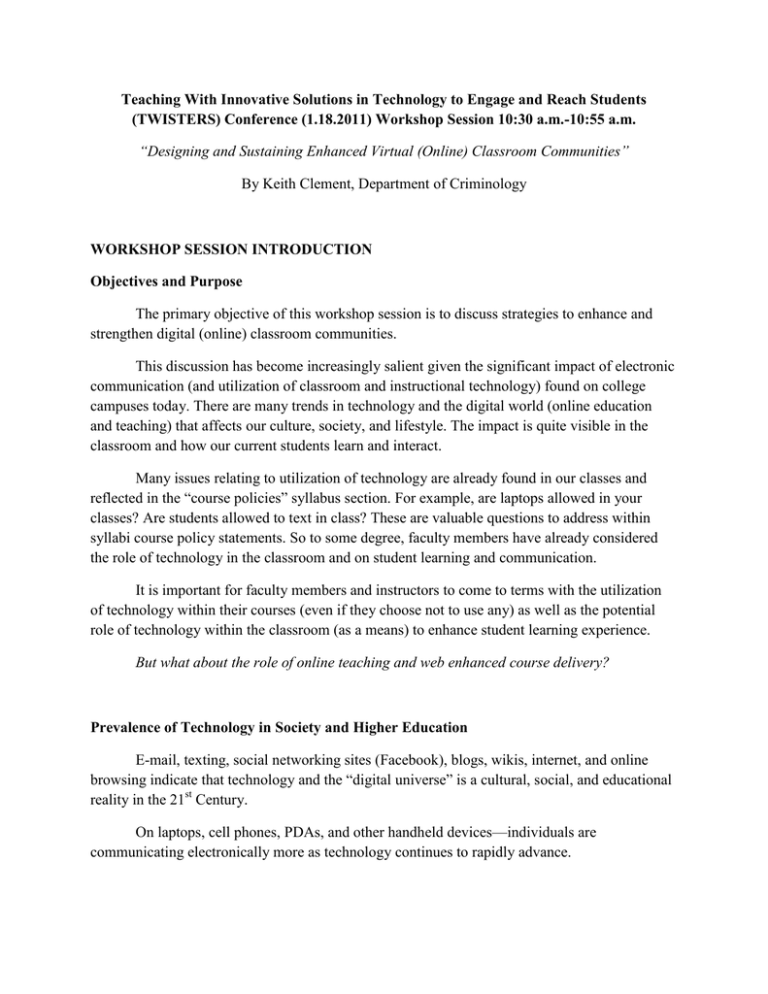Teaching With Innovative Solutions in Technology to Engage and Reach... (TWISTERS) Conference (1.18.2011) Workshop Session 10:30 a.m.-10:55 a.m.
advertisement

Teaching With Innovative Solutions in Technology to Engage and Reach Students (TWISTERS) Conference (1.18.2011) Workshop Session 10:30 a.m.-10:55 a.m. “Designing and Sustaining Enhanced Virtual (Online) Classroom Communities” By Keith Clement, Department of Criminology WORKSHOP SESSION INTRODUCTION Objectives and Purpose The primary objective of this workshop session is to discuss strategies to enhance and strengthen digital (online) classroom communities. This discussion has become increasingly salient given the significant impact of electronic communication (and utilization of classroom and instructional technology) found on college campuses today. There are many trends in technology and the digital world (online education and teaching) that affects our culture, society, and lifestyle. The impact is quite visible in the classroom and how our current students learn and interact. Many issues relating to utilization of technology are already found in our classes and reflected in the “course policies” syllabus section. For example, are laptops allowed in your classes? Are students allowed to text in class? These are valuable questions to address within syllabi course policy statements. So to some degree, faculty members have already considered the role of technology in the classroom and on student learning and communication. It is important for faculty members and instructors to come to terms with the utilization of technology within their courses (even if they choose not to use any) as well as the potential role of technology within the classroom (as a means) to enhance student learning experience. But what about the role of online teaching and web enhanced course delivery? Prevalence of Technology in Society and Higher Education E-mail, texting, social networking sites (Facebook), blogs, wikis, internet, and online browsing indicate that technology and the “digital universe” is a cultural, social, and educational reality in the 21st Century. On laptops, cell phones, PDAs, and other handheld devices—individuals are communicating electronically more as technology continues to rapidly advance. Today, smart-phones have many key features of laptop computers, television, digital cameras, video game console, electronic readers, telephone, etc. and are expected to replace many of these devices over the next decade or two. How have technological developments and online delivery of course materials changed the way we educate students? How different is the classroom today (in terms of technology) than when you were an undergraduate student? The changes are likely fairly significant. Faculty, Technology, and Impact on Our Courses Many faculty and students recognize the value of instructional technology and its potential impact within courses and student learning. If technology and the online revolution offer the potential of “enhanced” course delivery (whether fully online or blended format) and greater student learning (and success), then it’s role and impact on the classroom must be better understood. We ask faculty to stay current in their respective fields, but not so much in terms of classroom and instructional technology. Faculty and instructors should carefully consider the role and impact of technology and online delivery/resources as a means to increase student participation, learning, academic success, etc. in their courses One of these impacts is on the classroom community we endeavor to create, build, and sustain over the academic term for each of our classes. THE CLASSROOM COMMUNITY: What is meant by the term “classroom community?” (In other words, is it more than a group of people interacting in a common location like a classroom?) _______________________________________________________________________ What are some of the positive features of the traditional classroom learning community? ________________________ ________________________ ________________________ What are some of the limitations of traditional classroom communities? _________________________ _________________________ _________________________ THE VIRTUAL CLASSROOM COMMUNITY: One commonly echoed concern about online courses is that virtual courses cannot match the vibrant learning communities that often develop within the classroom. Pedagogical tools, evaluative measures, and teaching methods differ between traditional and virtual classrooms. But other important considerations like course student learning objectives, the need for effective communication, collaboration and participation, student engagement, and general course content do not. The online course format (whether completely online or a blended/hybridized model) utilizes a variety of tools and methods for communication and collaboration. Online education emphasizes independent learning, critical thinking, innovative thinking, writing skills, communication, cooperative group-work, and participation with classmates (these are all important skills to encourage and develop with students) Are these attributes also encouraged within the traditional classroom? BUILDING VIBRANT ONLINE CLASS COMMUNITIES: Thus, in order to build the virtual classroom, we must find innovative ways to link courses with technology to assist student learning and resources and to provide a more rich educational experience for the “digital generations.” One primary tool here is through the use of Online Asynchronous Discussions (OADs)— which are intended to encourage interaction and participation within the virtual classroom. So the question becomes, how can we build meaningful and strong classrooms online and virtually instead of the traditional classroom model? Is it possible to develop the same types of relationships and connect with students (and students connecting with their classmates?) online and outside of the brick and mortar classrooms? TOOLS AND TECHNIQUES TO ENHANCE ONLINE CLASSROOM COMMUNITIES 1. Have students introduce themselves to classmates. One way to assist a class to a quick start in the course is to facilitate students getting to know their peers through a short reflection essay (one paragraph or so). The short essay should ask students to describe their major, professional goals, and anything else of note/interest. This essay should be placed on the community board. 2. Form smaller discussion groups. To develop closer ties, arrange groups of 6-8 students and have them work together on the reflection posts and reposts. Ideally, each course would be arranged into 6-8 groups of 6-8 students each. This assists with continuity over the course of the semester. In addition, if the group has concerns about a particular group member (or their posts), it is easy to move them into another group. 3. Instead of students developing one long post per week (i.e. 250 words), have students prepare an initial post (and then reposts addressing issues found in fellow student’s postings). Prepare a grading rubric that stresses the need for the integration of the ideas of other students in the posting to maximize grades. (Please contact me if you would like an example grading rubric here). 4. Innovate methods of student evaluation in online coursework. Online discussion involves several current methods of evaluation: Counting number of posts/reposts (minimum word limits)- Quantitative, utilization of grading rubric Evaluating student response (and participation) to writing prompts (assignments)- Qualitative, more subjective, often utilizing “reflection papers.” Group work- team projects? 5. What are additional ways we can innovate to enhance and strengthen online (virtual) classroom communities? Any questions or comments? Please contact me at kclement@csufresno.edu if you have any.



